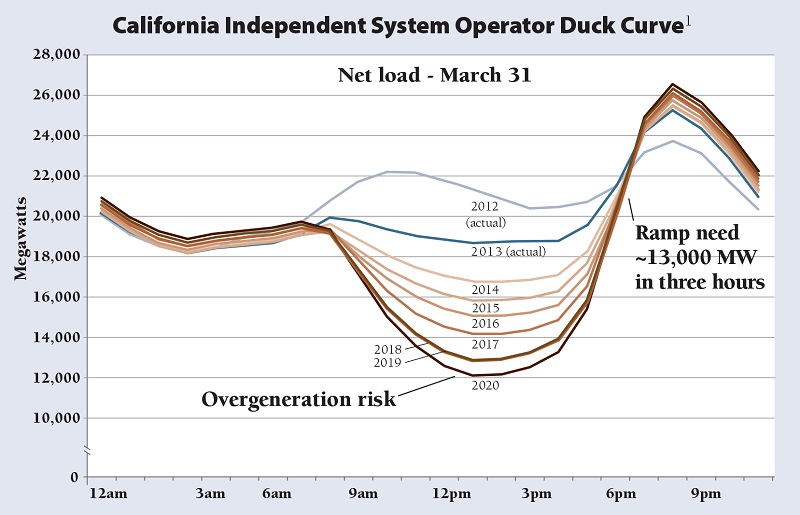As highlighted in our earlier post, Beneficial Electrification: Opportunity Knocks for Utilities, the power sector is rapidly transforming. Today’s older, inflexible resources are being retired, the grid is becoming more flexible, resources are getting cleaner and more distributed, and customers are consuming, saving, and producing energy in new ways.
Beneficial electrification—which refers to electrifying energy end-uses usually powered by fossil fuels—secures a variety of positive outcomes and represents a major opportunity within power sector transformation. Examples of beneficial electrification include electric water heating, space heating, and electric vehicle charging. One of the central benefits of electrification is pollution reduction, but it’s far from the only dividend. It will also improve management of the electricity grid.
Benefits for Grid Operators
Because electricity cannot be stored in large amounts yet—it must be generated at the same time it is used—utilities must keep supply in constant balance with demand to avoid grid disruptions. With the growth of intermittent resources (e.g., wind and solar), balancing grid systems is much more challenging today than in the past. Because demand and supply both fluctuate now, grid operators must command flexible resources to ensure grid stability. Thus, a key requirement for grid operators today is meeting “net load”—the difference between forecasted load and the amount of load met by intermittent resources.
As Jim Lazar writes in Teaching the Duck to Fly, utilities are becoming more sensitive to the shape of customer loads because it is difficult for conventional generation to ramp up and down as quickly as renewable energy supplies wax and wane. Bringing on larger generation resources, the traditional balancing solution, doesn’t work well under these circumstances because these units weren’t designed for rapid cycling.

Grid operators now recognize that demand-side efforts can help meet today’s balancing challenges. Specifically, optimizing load shape through a combination of policies, pricing options, and program offerings can make the system more flexible and lower its overall costs. Beneficial electrification provides some of the best ways to optimize load shape. Three examples follow.
Electric Water Heating
Water heating is concentrated in the peak morning and evening hours, when residential consumers start and end their days. However, water can be pre-heated when power is most available and demand is low, and then used subsequently. So, system balancing can benefit from using electric heat pumps to heat water at night (sourced by wind) or midday (sourced by solar), rather than fossil alternatives.
Used in this manner, electric water heaters become “hidden batteries” waiting to be used. Water heaters generally hold about a day’s supply of hot water in reserve, so their electricity consumption can readily be shifted between time periods as needed. This way, switching from fossil water heaters to electric heaters brings flexibility to the grid.
Space Heating and Cooling
Air conditioning is the primary contributor to peak demand for many U.S. utilities. Most cooling is already electric, but air conditioning units in the commercial sector are large enough that ice or chilled-water storage capacity can be used to shift cooling load to off-peak periods. Ice storage is commercially available on conditioning systems serving a wide range of commercial building sizes. Utilizing this technology enables utilities to run compressors and chillers at night (on wind) or midday (on solar) and to curtail load during ramping hours. Residential-scale ice-storage heat pump air conditioners are also entering the market.
In space heating, where fossil alternatives have historically predominated, electrification also holds great promise, especially in new construction. Smart thermostats, for example, “learn” customers’ heating and cooling requirements, enabling them to reduce overall (and peak) usage. Electric thermal storage can also help balance grid systems with high levels of variable renewables. Space heating loads can be time-shifted to some degree, like water heating loads. The bottom line: electric space heating can help grid operators do their job.
Electric Vehicles
The rapidly developing market for electric vehicles also provides a significant beneficial electrification opportunity for a variety of reasons, including grid management. The Rocky Mountain Institute’s recent study, Electric Vehicles as Distributed Energy Resources, notes that a car with a 30 kWh battery can store as much electricity as the average U.S. residence consumes in one day. “Smart charging” of this new load can ensure that cars are charged off-peak, mostly with low-cost power and often tapping variable renewable resources.
New vehicle-to-grid technologies are emerging that will enable electric vehicle batteries to return power to the grid during periods of extreme load. And finally, electric vehicle batteries can supply valuable fast-response grid services, such as frequency regulation and voltage support. Electric vehicles are essentially batteries on wheels, providing demand and, eventually, supply that is movable in both time and space, so electrification of vehicles can be a tool for balancing, ancillary services, and peak shaving.
Managing the Grid Hinges on Managing Demand
Managing and shaping electrical load is increasingly critical to grid system balancing, and beneficial electrification provides grid operators with greater opportunity to do so. Newly electrified loads can be shifted—through appropriate rate designs, for example—to times when electricity is cleaner and more available, away from periods that require dispatching more expensive, more polluting generation units.
Managing electricity supply and demand has never been more challenging. Electrifying water heating, space heating, and transportation will enable utilities and ratepayers to better shape their loads, making it easier for managers to tend the grid. This, in turn, will enhance the value and extend the life of existing grid assets, help avoid risky investments in new energy infrastructure, aid in integrating renewables, and reduce environmental impacts. Utilities, consumers, and society will all gain as a result.
